Abstract
At separate institutions, pattern reversal visual evoked potentials (VEPs) were recorded in children and older patients with phenylketonuria and compared with MRI of the brain. In nine patients aged less than 14 years, who were still on a diet low in phenylalanine, VEPs were clearly abnormal in only one and the abnormalities seen on MRI were mild. In 27 patients aged 14-31 years VEPs were abnormal in more than 80%, with significant reduction of amplitude and prolongation of latency despite the general absence of visual symptoms and abnormalities on routine neuro-ophthalmological examination. Among the older patients there was no significant correlation between VEP measures and plasma phenylalanine or tyrosine concentrations; neither was the incidence of VEP abnormalities dependent on whether or not the patients were still on a low phenylalanine diet. Some VEP amplitude measures were inversely correlated with the MRI lesion score, perhaps reflecting the severity of white matter abnormalities in the parieto-occipital region. In the older patients the amplitude of VEPs to stimulation of the central 8 degrees of the visual field was significantly correlated with IQ. The study confirms the high incidence of subclinical visual pathway involvement in older children and adults with phenylketonuria, and suggests the possibility of a link between the abnormal appearance of subcortical white matter on MRI and a physiological index of function of the CNS. As there was no evidence of general intellectual decline, it is suggested that the correlation between central field VEP amplitude and IQ may reflect abnormal development during infancy. Abnormalities on MRI, on the other hand, seem to be more closely related to current dietary state and phenylalanine concentration.
Full text
PDF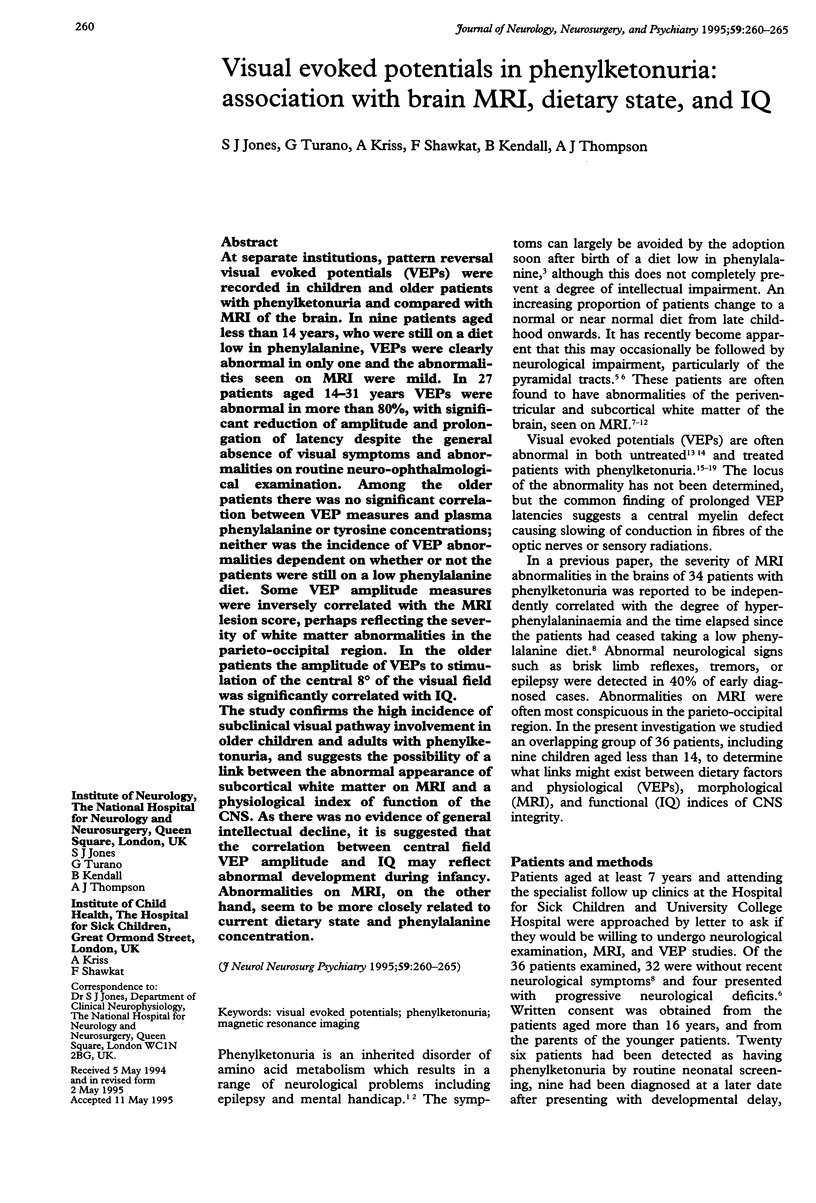
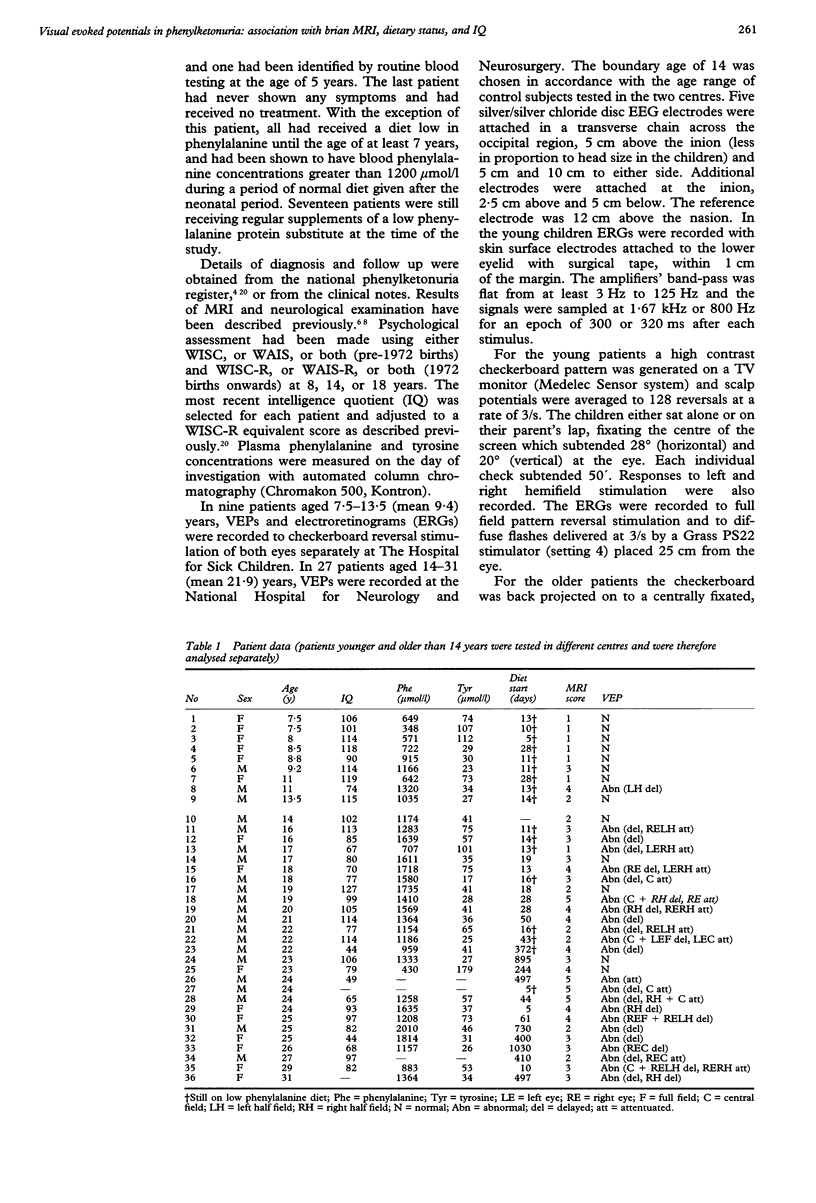
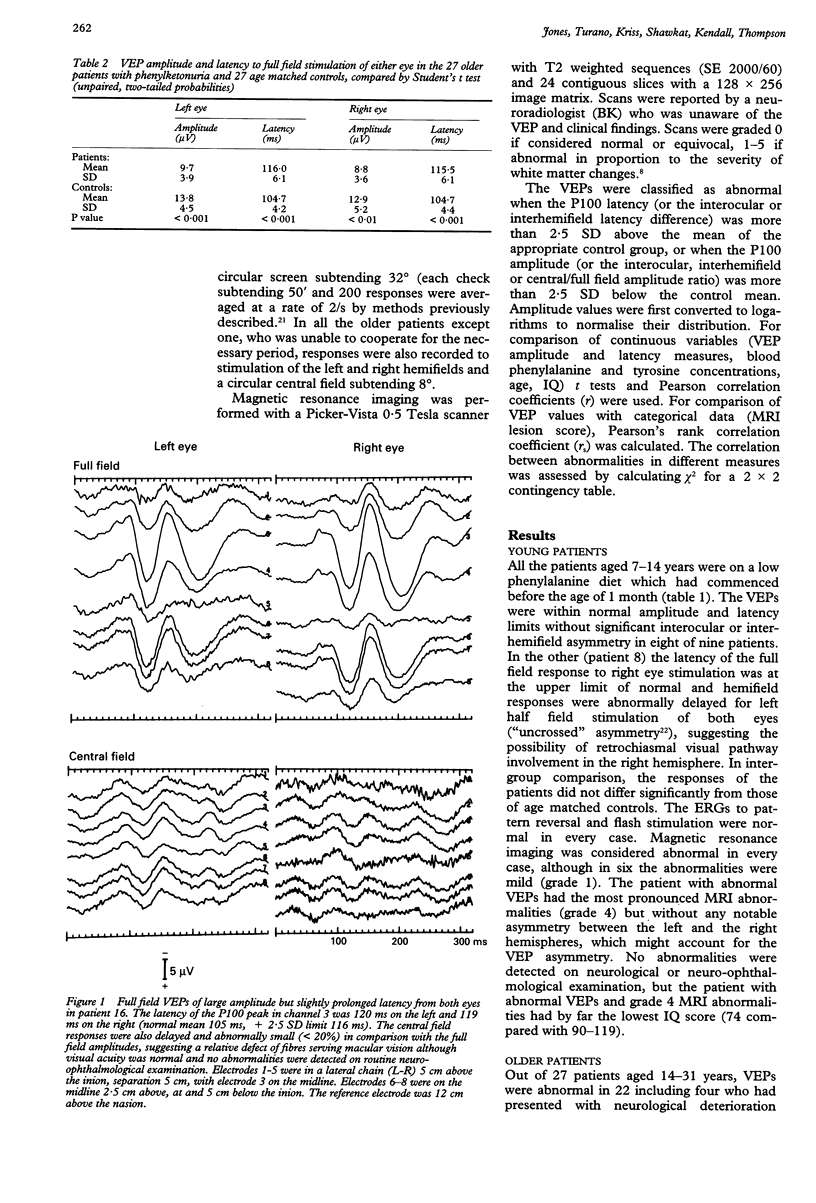
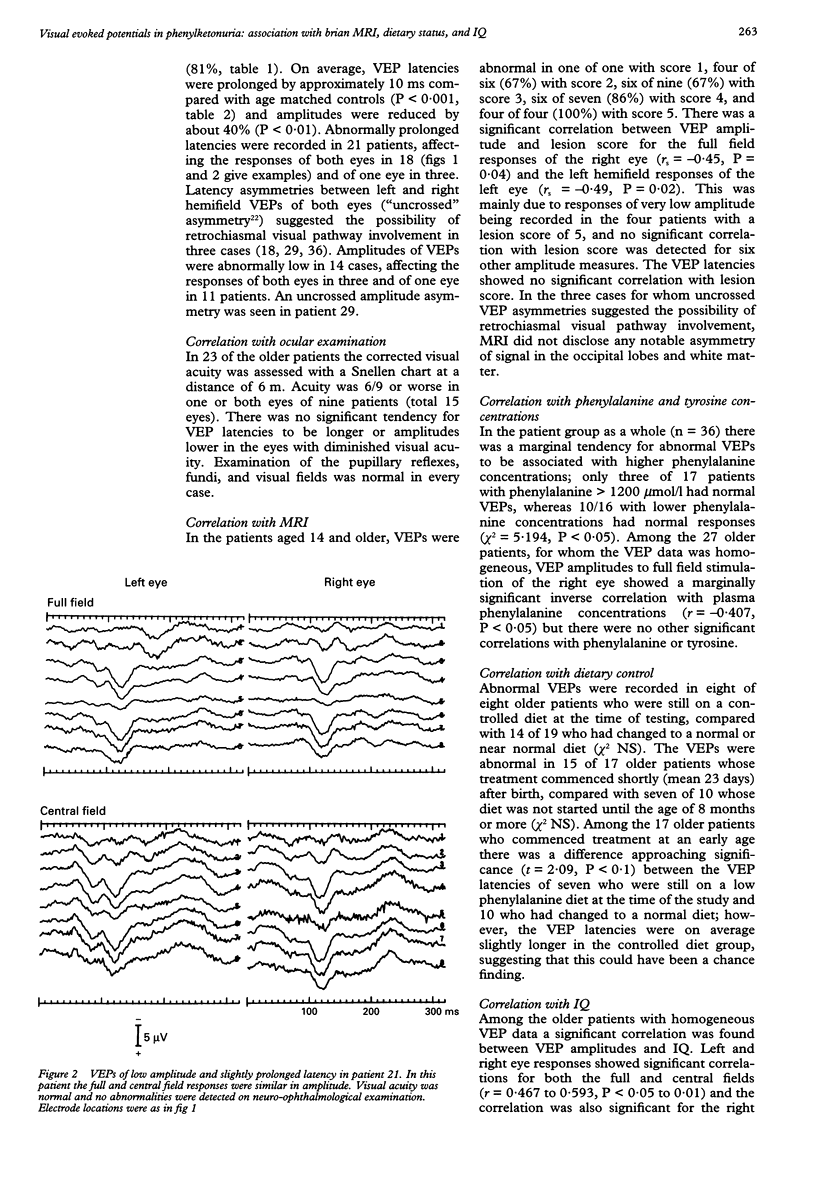
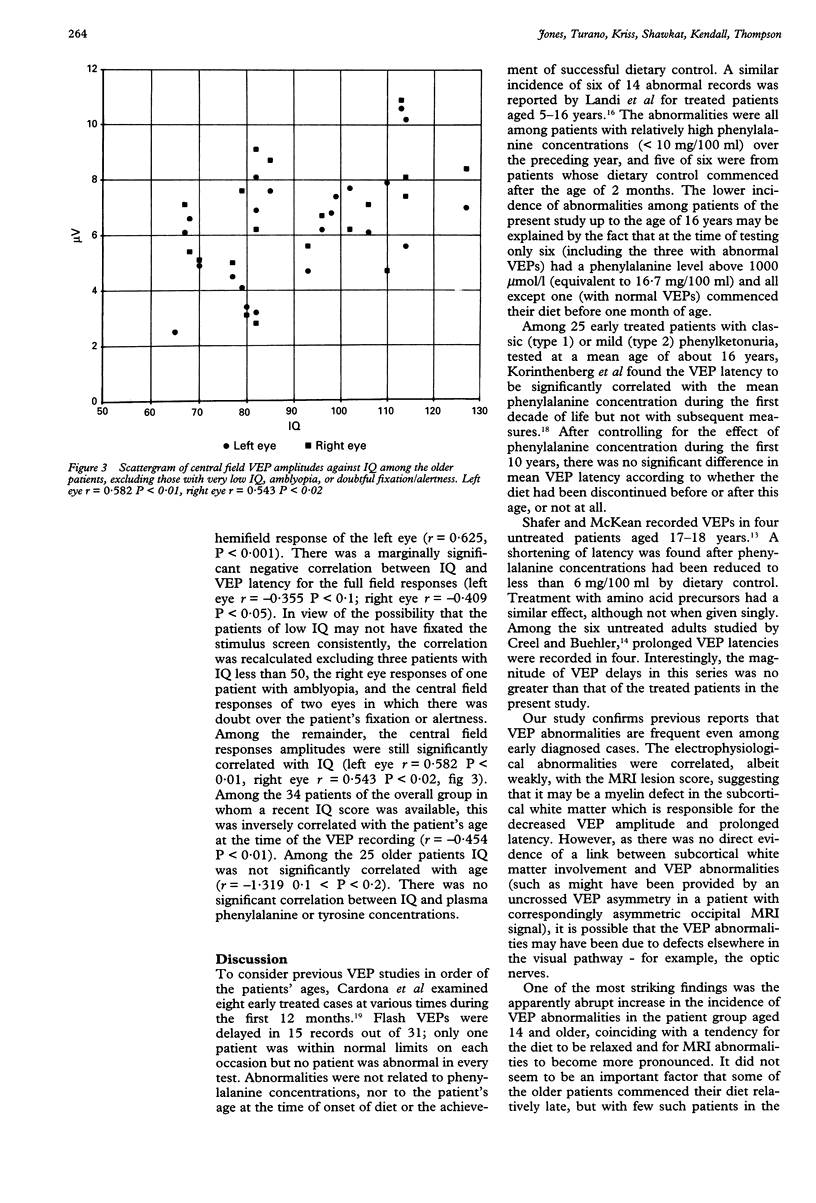
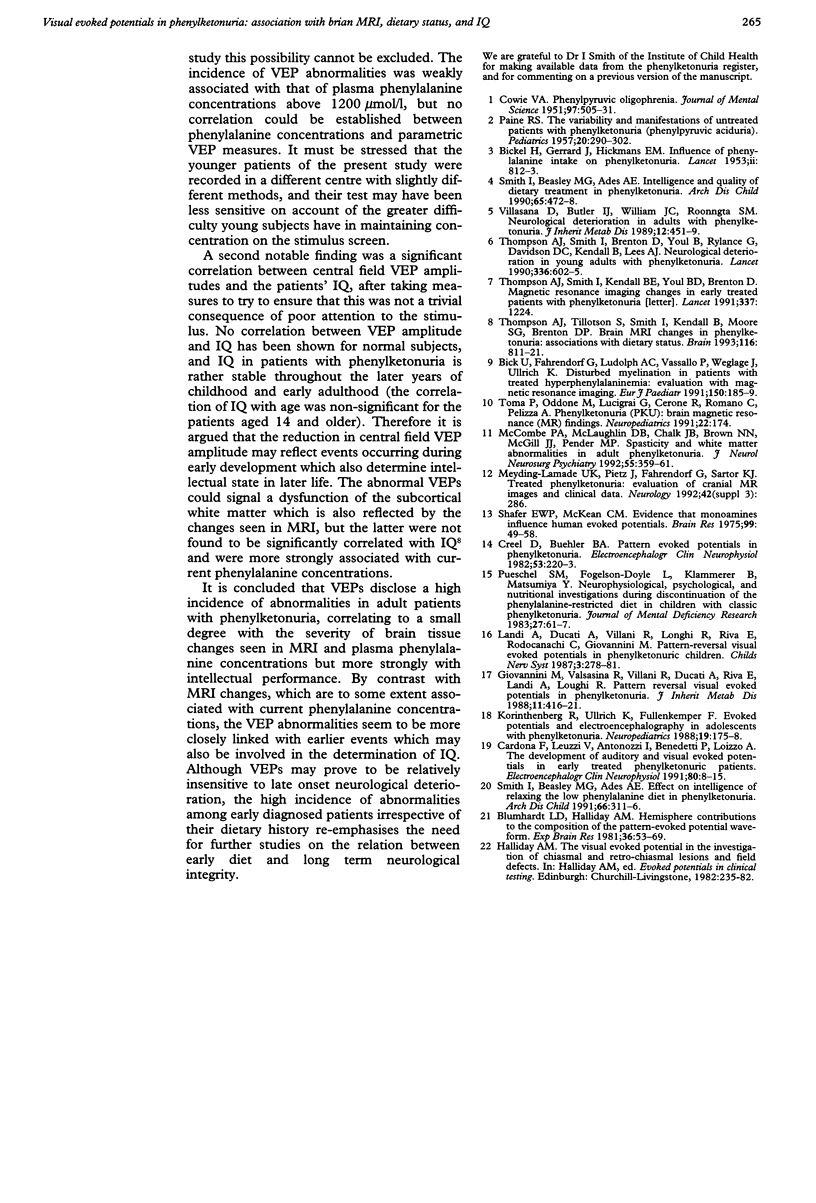
Selected References
These references are in PubMed. This may not be the complete list of references from this article.
- BICKEL H., GERRARD J., HICKMANS E. M. Influence of phenylalanine intake on phenylketonuria. Lancet. 1953 Oct 17;265(6790):812–813. doi: 10.1016/s0140-6736(53)90473-5. [DOI] [PubMed] [Google Scholar]
- COWIE V. Phenylpyruvic oligophrenia. J Ment Sci. 1951 Jul;97(408):505–531. doi: 10.1192/bjp.97.408.505. [DOI] [PubMed] [Google Scholar]
- Creel D., Buehler B. A. Pattern evoked potentials in phenylketonuria. Electroencephalogr Clin Neurophysiol. 1982 Feb;53(2):220–223. doi: 10.1016/0013-4694(82)90026-8. [DOI] [PubMed] [Google Scholar]
- Giovannini M., Valsasina R., Villani R., Ducati A., Riva E., Landi A., Longhi R. Pattern reversal visual evoked potentials in phenylketonuria. J Inherit Metab Dis. 1988;11(4):416–421. doi: 10.1007/BF01800430. [DOI] [PubMed] [Google Scholar]
- Korinthenberg R., Ullrich K., Füllenkemper F. Evoked potentials and electroencephalography in adolescents with phenylketonuria. Neuropediatrics. 1988 Nov;19(4):175–178. doi: 10.1055/s-2008-1052440. [DOI] [PubMed] [Google Scholar]
- Landi A., Ducati A., Villani R., Longhi R., Riva E., Rodocanachi C., Giovannini M. Pattern-reversal visual evoked potentials in phenylketonuric children. Childs Nerv Syst. 1987;3(5):278–281. doi: 10.1007/BF00271823. [DOI] [PubMed] [Google Scholar]
- McCombe P. A., McLaughlin D. B., Chalk J. B., Brown N. N., McGill J. J., Pender M. P. Spasticity and white matter abnormalities in adult phenylketonuria. J Neurol Neurosurg Psychiatry. 1992 May;55(5):359–361. doi: 10.1136/jnnp.55.5.359. [DOI] [PMC free article] [PubMed] [Google Scholar]
- PAINE R. S. The variability in manifestations of untreated patients with phenylketonuria (phenylpyruvic aciduria). Pediatrics. 1957 Aug;20(2):290–302. [PubMed] [Google Scholar]
- Pueschel S. M., Fogelson-Doyle L., Kammerer B., Matsumiya Y. Neurophysiological, psychological, and nutritional investigations during discontinuation of the phenylalanine-restricted diet in children with classic phenylketonuria. J Ment Defic Res. 1983 Mar;27(Pt 1):61–67. doi: 10.1111/j.1365-2788.1983.tb00164.x. [DOI] [PubMed] [Google Scholar]
- Schafer E. W., McKean C. M. Evidence that monoamines influence human evoked potentials. Brain Res. 1975 Nov 28;99(1):49–58. doi: 10.1016/0006-8993(75)90607-1. [DOI] [PubMed] [Google Scholar]
- Smith I., Beasley M. G., Ades A. E. Intelligence and quality of dietary treatment in phenylketonuria. Arch Dis Child. 1990 May;65(5):472–478. doi: 10.1136/adc.65.5.472. [DOI] [PMC free article] [PubMed] [Google Scholar]
- Thompson A. J., Smith I., Brenton D., Youl B. D., Rylance G., Davidson D. C., Kendall B., Lees A. J. Neurological deterioration in young adults with phenylketonuria. Lancet. 1990 Sep 8;336(8715):602–605. doi: 10.1016/0140-6736(90)93401-a. [DOI] [PubMed] [Google Scholar]
- Thompson A. J., Smith I., Kendall B. E., Youl B. D., Brenton D. Magnetic resonance imaging changes in early treated patients with phenylketonuria. Lancet. 1991 May 18;337(8751):1224–1224. doi: 10.1016/0140-6736(91)92894-8. [DOI] [PubMed] [Google Scholar]
- Thompson A. J., Tillotson S., Smith I., Kendall B., Moore S. G., Brenton D. P. Brain MRI changes in phenylketonuria. Associations with dietary status. Brain. 1993 Aug;116(Pt 4):811–821. doi: 10.1093/brain/116.4.811. [DOI] [PubMed] [Google Scholar]
- Villasana D., Butler I. J., Williams J. C., Roongta S. M. Neurological deterioration in adult phenylketonuria. J Inherit Metab Dis. 1989;12(4):451–457. doi: 10.1007/BF01802042. [DOI] [PubMed] [Google Scholar]


